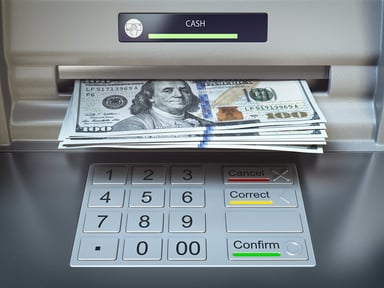Everything You Need To Know About ATM Transactions

An ATM, otherwise known as an automated teller machine, is a machine that makes accessing or withdrawing funds a convenient and fairly easy process. The steps are usually quick and simple: Walk up, enter your card and PIN number, and make withdrawals or deposits. While there are certain benefits to using an ATM, there are a few things that you should know and consider before using one to access your money.
First thing’s first, what exactly is an ATM transaction and how does it work? An ATM can help people perform a variety of functions, from allowing for electronic banking, cash deposits and withdrawals, bill payments, to enabling the transfer of funds between accounts. How does it do this? In order to grant access to funds, ATMs require a debit or ATM card and a personal identification or PIN number. From there, money is electronically drawn from one’s account.
There are several transactions that can be executed, including:
- Point of sale - ATM cards and debit cards can be used in stores to charge merchandise
- Pre-authorized transfers - Allow for the automatic deposit or withdrawal of funds to and from one’s account
- Phone transfers - ATMs can help to make a transfer of funds between accounts over the phone
There are also various functions that some ATMs can perform, such as:
- Provide access to gold - Some ATM machines throughout Europe, the Middle East, and Florida can dispense gold coins and bars instead of cash
- Track monthly withdrawals - Certain ATMs will allow their customers a monthly target amount that will notify the person each time they make a withdrawal
- Offer intelligent deposit - This function accepts checks or stacks of bills rather than cards alone
Now, it should be noted that when using an ATM machine, there are a number of things to be wary of.
1) Safety: The first and perhaps most important point is that you should always make sure your surroundings are safe and private when using an ATM machine. Because your personal information and card are easily accessible while using the machine, you don’t want any of that to get in the wrong hands. Make sure to cover your PIN number when entering and to keep a close eye on your card when it’s being used by the machine.
2) Receipts: Most ATMs will give you a receipt for your transaction, so it’s important to keep this with you. Be sure not to throw this away anywhere, as it could hold personal information that could be used to access your money.
3) Report anything out of the ordinary: Sometimes interesting things can happen at ATM machines. For example, if the amount of money you wanted to withdraw was not produced, or the machine kept your card, call your bank immediately to notify them.
Similarly, in the event that someone else has accessed your information and made a withdrawal that was not approved by you, you should contact your bank. They may ask you to submit your account information and the problem in writing and will generally provide an answer or compensation within 10 business days.
4) Using your ATM card in a foreign country: ATM machines exist all over the world, so you can access your money from anywhere. However, it may be prudent to notify or check in with your bank before doing so. If you have an ATM card, you can withdraw foreign currencies at a better exchange rate and also report any losses more effectively.
You should be aware that your bank may charge foreign transaction fees for each withdrawal, so it may be better to withdraw cash in large amounts to reduce the number of transactions you have overall.
To summarize: be safe, be wise, and call your bank if you have any problems or questions.

